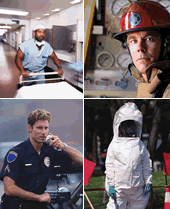EMERGENCY RESPONSE RESOURCES

Terrorism Response
No one wants to think about a terrorist attack but it is important to be prepared just in case such an event happens. This page provides information to help protect emergency responders in the event of a terrorist attacks. It links to information on response to the World Trade Center attacks. This page also offers access to information on other important elements of a terrorism response such as Safeguarding Building Ventilation, Bloodborne Infectious Disease, Chemical Hazards and Anthrax.
Safety Management
Protecting Emergency Responders, Safety Management in Disaster and Terrorism Response
NIOSH and RAND produced four reports in a series. The first three reports provide recommendations and the need for research, training and other strategic approaches to help protect emergency responders in terrorist attacks. The fourth report is a technical source for incident commander guidelines for emergency response immediately following large structural collapse events. Each individual report can be accessed using the following links:
- Volume 1 Protecting Emergency Responders: Lessons Learned from Terrorist Attacks
- Volume 2 Protecting Emergency Responders, Volume 2: Community Views of Safety and Health Risks and Personal Protection Needs
- Protecting Emergency Responders, Volume 3: Safety Management in Disaster and Terrorism Response (DHHS (NIOSH) Publication No. 2004-144)
- Personal Protective Equipment Guidelines for Structural Collapse Events, Rand Volume 4
World Trade Center
NIOSH Safety and Health Topic: World Trade Center Response
Currently, NIOSH funds programs to provide medical screening, monitoring, and treatment for responders who served at the WTC site. Links to information about the NIOSH response, and World Trade Center health resources, can be found here.
Safeguarding Building Ventilation
NIOSH Guidance for Filtration and Air-Cleaning Systems to Protect Building Environments from Airborne Chemical, Biological, or Radiological Attacks
NIOSH Pub No. 2003-136
Provides preventive measures, recommendations, air-cleaning principles, and economic considerations for building owners and managers to implement to protect building air environments from a terrorist release of chemical, biological, or radiological contaminants.
NIOSH Guidance for Protecting Building Environments from Airborne Chemical, Biological, or Radiological Attacks
NIOSH Pub. No. 2002-139
Identifies actions and recommendations as well as information on things not to do; physical security; ventilation and filtration; and maintenance, administration, and training for building owners or managers to quickly implement to enhance occupant protection from an airborne chemical, biological, or radiological attack.
Bloodborne Infectious Disease
NIOSH Emergency Responder Bloodborne Infectious Disease Page
Provides links to resources and guidelines including engineering controls and work practices to help workers prevent exposure to blood and other body fluids.
Chemical Hazards
NIOSH Emergency Response Chemical Hazards Page
Chemical agent information is needed for workers to appropriately plan for risks resulting from possible chemical incidents. Several organizations have developed information databases, including short-term and long-term criteria, each with specific purposes, exposure scenarios, and severity of adverse health effects considered in their development.
Anthrax
NIOSH Anthrax Topic Page
Provides information about anthrax including recommendations for protecting workers, environmental sampling, past responses and investigations, and other resources.
Mail Handlers
NIOSH Irradiated Mail Topic Page
Contains information on OPM reports and Health Hazard Evaluations conducted in response to requests from postal employees, federal workers, and Congressional employees.
CDC Interim Recommendations for Protecting Workers from Exposure to Bacillus anthracis in Work Sites Where Mail Is Handled or Processed
Guidance for implementing engineering, administrative, and housekeeping controls; advice for mail workers.
Evaluation of Bacillus anthracis Contamination Inside the Brentwood Mail Processing and Distribution Center --- District of Columbia, October 2001
MMWR December 21, 2001 / 50(50);1129-1133
This report describes the results of CDC's evaluation of B. anthracis in the Brentwood Mail facility, which showed widespread contamination of the facility and suggest that wipe samples and high efficiency particulate air (HEPA) vacuum samples complement each other in assessing contamination.
Responding to Detection of Aerosolized Bacillus anthracis by Autonomous Detection Systems in the Workplace
MMWR April 30, 2004 / 53
Examines the development and use of Autonomous detection systems (ADS) to detect agents of biologic and chemical terror in the environment. These systems will eventually be able to detect biologic and chemical hazards reliably and provide approximate real-time alerts that an agent is present.
- Page last reviewed: August 14, 2013
- Page last updated: December 2, 2016
- Content source:
- National Institute for Occupational Safety and Health Office of the Director


 ShareCompartir
ShareCompartir